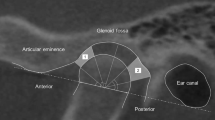Abstract
Purpose
Vitamin D plays an essential role in subchondral bone, cartilage, and periarticular muscle. This study aims to assess the prevalence of vitamin D deficiency in temporomandibular disorder (TMD) patients.
Materials and methods
This is a cross-sectional study. Subjects were assigned into two groups based on having signs and symptoms of TMD: Group 1: subjects had TMD, and group 2 healthy group (control group). The serum level of vitamin D was measured in the two groups. The independent t test was used to compare the serum level of vitamin D between the study and control groups.
Results
One hundred ten subjects were studied into two groups (55 subjects in each group). The mean serum level of vitamin D was 18.13 ± 6.38 ng/mL in the study group and 31.83 ± 7.00 ng/mL in the control group. Analysis of the data demonstrated a significant difference in the mean serum level of vitamin D between the study and control groups (p = 0.001).
Conclusion
It seems the serum level of vitamin D is lower in TMD patients than in the healthy control group.

Similar content being viewed by others
References
Janal MN, Raphael KG, Nayak S, Klausner J (2008) Prevalence of myofascial temporomandibular disorder in US community women. J Oral Rehabil 35(11):801–809
Ryan J, Akhter R, Hassan N, Hilton G, Wickham J, Ibaragi S (2019) Epidemiology of temporomandibular disorder in the general population: a systematic review. Adv Dent Oral Health 10(3):1–13
Shen M, Luo Y, Niu Y, Chen L, Yuan X, Goltzman D, Miao D (2013) 1, 25 (OH) 2D deficiency induces temporomandibular joint osteoarthritis via secretion of senescence-associated inflammatory cytokines. Bone 55(2):400–409
Zhang FF, Driban JB, Lo GH, Price LL, Booth S, Eaton CB et al (2014) Vitamin D deficiency is associated with progression of knee osteoarthritis. J Nutr 144(12):2002–2008
Khanna SS, Parulekar NR, Dhaimade PA (2017) The influence of vitamin D on the temporomandibular joint and the activities of daily living. J ClinDiagnost Res 11(11):31–34
Yildiz S, Tumer MK, Yigit S, Nursal AF, Rustemoglu A, et al. Relationship of Vitamin D and Bsml variant with Temporomandibular Diseases in Turkish population. Br J Oral Maxillofac Surg. Doi: https://doi.org/10.1016/j.bjoms.2020.08.101
Singh R, Kaur S (2018) Etiology of temporomandibular disorder-a brief review: part I. J Adv Med Dental Sci Res 6(10):78–81
Garfinkel RJ, Dilisio MF (2017) Agrawal DKJOJoSM. Vitamin D Effects Articular CartilOsteoarthr 5(6):2325967117711376
Staniszewski K, Lygre H, Berge T, Rosén AJPR (2019) Management Serum Analysis in Patients with Temporomandibular Disorders: a Controlled Cross-Sectional Study in Norway. Pain Res Manag. https://doi.org/10.1155/2019/1360725
Demir CY, Ersoz ME (2019) Biochemical changes associated with temporomandibular disorders. J Int Med Res 47(2):765–771
Gao XR, Chen YS, Deng W (2017) The effect of vitamin D supplementation on knee osteoarthritis: a meta-analysis of randomized controlled trials. Int J Surg 46:14–20
Yu Y, Liu D, Feng D, Zhao J (2020) Association between vitamin D and knee osteoarthritis: a PRISMA-compliant meta-analysis. Z OrthopUnfall. https://doi.org/10.1055/a-1098-8815
Heidari B, Heidari P, Hajian-Tilaki K (2011) Association between serum vitamin D deficiency and knee osteoarthritis. Int Orthop 35(11):1627–1631
Vaishya R, Vijay V, Lama P, Agarwal A (2019) Does vitamin D deficiency influence the incidence and progression of knee osteoarthritis?—a literature review. J ClinOrthopaed Trauma 10(1):9–15
Bertoli FMDP, Bruzamolin CD, Pizzatto E, Losso EM, Brancher JA, de Souza JF (2018) Prevalence of diagnosed temporomandibular disorders: a cross-sectional study in Brazilian adolescents. PLoS ONE 13(2):e0192254
Funding
No funding.
Author information
Authors and Affiliations
Contributions
RT, FR, and SG performed the research and documented subjects’ data. SN designed the study and analyzed and interpreted the patient data.
Corresponding author
Ethics declarations
Conflict of interest
The authors declare that they have no conflict of interests.
Ethics approval
The committee approved the study of the medical ethics group of Shahid Beheshti University of Medical Sciences. (IR.SBMU.DRC.REC.1398.100).
Consent to participate
All subjects signed a consent form to participate in the study.
Availability of data and material
The datasets used and/or analyzed during the current study are available from the corresponding author on reasonable request.
Additional information
Publisher's Note
Springer Nature remains neutral with regard to jurisdictional claims in published maps and institutional affiliations.
Rights and permissions
About this article
Cite this article
Nemati, M., Tabrizi, R., Rasooli, F. et al. Is the Prevalence of Vitamin D deficiency in Patients with Temporomandibular Disorder Higher than Healthy Control Group?. J. Maxillofac. Oral Surg. 21, 1205–1208 (2022). https://doi.org/10.1007/s12663-021-01522-3
Received:
Accepted:
Published:
Issue Date:
DOI: https://doi.org/10.1007/s12663-021-01522-3




